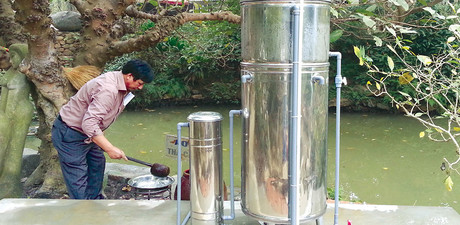Award-winning filtration system removes arsenic from groundwater

A low-cost project to remove arsenic and deliver safe and clean drinking water has won a $500,000 Technology Against Poverty prize from the Australian Government’s innovationXchange and Google.org, the philanthropic arm of Google.
The prize was presented to Distinguished Professor Saravanamuth Vigneswaran and Dr Tien Vinh Nguyen from UTS for their project to remove pollutants from groundwater in Vietnam’s Red River Delta — a densely populated area that is beset with serious public health issues caused by high levels of arsenic in the groundwater. Current systems are neither cost-effective nor efficient at removing arsenic.
Working with Vietnamese partners, including the Vietnam National University (VNU), the Vietnam Academy of Science and Technology (VAST) and local manufacturers, the UTS team is deploying inexpensive technology to provide a model for clean water that can be adopted worldwide to improve water quality for the more than 130 million people experiencing toxicity from naturally occurring arsenic.
“There are three key components to this system: an organic membrane, a tank/drum in which the membrane is inserted and an absorptive cartridge made from locally available industrial waste products,” Distinguished Professor Vigneswaran said. Local manufacturers can produce, install and maintain the membranes and cartridges, creating local jobs in an area of high population growth.
“The filtration can be powered by gravity or solar or by hand pump,” continued Distinguished Professor Vigneswaran. “Membranes will last up to three years, while the cartridges absorb the arsenic and are periodically replaced with new ones (every three to six months). The waste cartridges will be turned into safe building materials, so the system safely disposes of arsenic waste.”
The system will also remove bacteria and solids from the contaminated groundwater, delivering water that is clean and safe to drink, and is scalable: for example, a 10 m3 system will provide uncontaminated water for 100 people.
“This sustainable system will both maximise locally sourced resources and minimise arsenic waste and environmental pollution, improving health and quality of life,” Distinguished Professor Vigneswaran said.
Australia on way to meet EEC targets
The country should 'stay the course' on home energy renovations to support...
CSIRO 'Living Lab' to shape NSW's energy future
NSW households and small businesses can learn how to potentially unlock lower power bills and...
Researchers to supercharge Australia's grid resilience
QUT research is harnessing the skills of engineers, data scientists and behavioural economists to...










